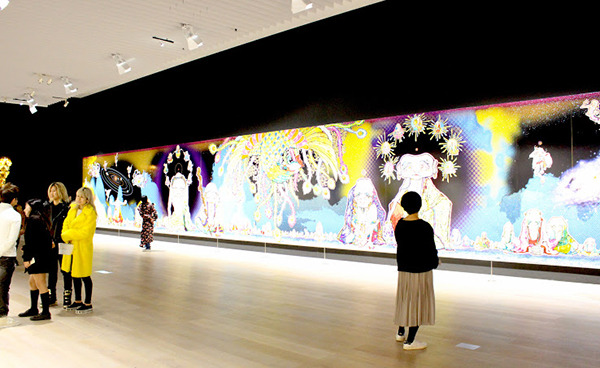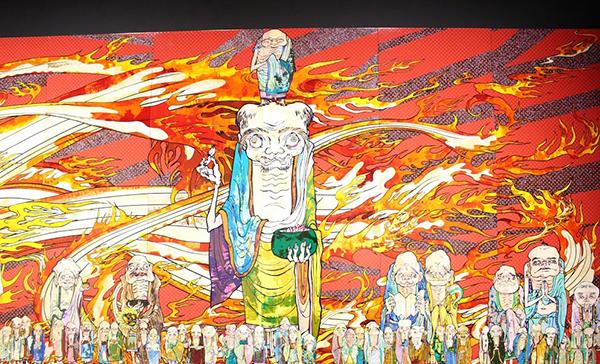Artlyst’s Japan correspondent Rachel Carvosso has attended “Takashi Murakami; The 500 Arhats” at the Mori Museum in Roppongi, Tokyo; the artist’s first large-scale Japan-based exhibition in the last 14 years, featuring works previously unseen in the country.
The work of the exhibition title is a hugely ambitious project that boasts of being one of the “largest paintings ever produced in global art history”. At 100m long the painting was created as a token of gratitude to the State of Qatar in the wake of their assistance to Japan after the 2011 Great East Japan Earthquake.
The centerpiece is based on the Legendary Chinese guardians of the four “celestial” directions (Blue Dragon – East, White Tiger – West, Vermilion Bird – South, Black Tortoise – North) whose imagery came to Japan during the Heian Period (8th – 12th centuries). The monumental work was created with the assistance of over 200 students from various Japanese Art colleges and is reminiscent of Kano Kazunobu`s (1816 – 1863) scroll consisting of 100 separately painted scrolls. The idea itself being triggered by an ongoing dialogue with Art Historian Tsuji Nobuo where Murakami produced a new work in response to an essay by Tsuji. As part of the exhibition the “Nippon E`awase” magazine dialogues are presented and the work contextualised by paintings of 500 Arhats by Nagasawa Rosetsu (1754 – 1799) in addition to Kazunobu, Rosetsu`s work depicts the scenes on a 3cm square surface contrasting to the huge scale of Murakami`s wall painting and serves to connect the Edo period to contemporary times.
 Image: Takashi Murakami: The 500 Arhats – Mori Art Museum, Roppongi, Tokyo, photo Rachel Carvosso, © Artlyst 2016.
Image: Takashi Murakami: The 500 Arhats – Mori Art Museum, Roppongi, Tokyo, photo Rachel Carvosso, © Artlyst 2016.
The work itself is epic in scale and mixes strong psychedelic colours with updated imagery of monks in prayer, other worldly beings and mythical animals. Notorious for his association with “Otaku” culture*, Murakami exploded onto the International Art Scene in 2005 when he curated his “Superflat” exhibitions in multiple locations including New York and LA. “Superflat” – the idea that everything is on the same level regardless of whether it is “high” or “low” art was in its own way the continuation of the annihilation of Greenburg`s theories. Post War Japan was able to negotiate the influences of the West to create a bridge with it`s own art history, within the superflat matrix manga could happily co-exist alongside the work of Edo period painters.
The internet it could be argued is the ultimate “superflat” experience. The success and relevance of the curation and underlying conceptual base added to his international acclaim and championing of what was viewed as a stream of Japanese pop art. No longer was there a lack of paradigm within which to view the eclectic Japanese art scene with its focus on craft and tradition or neo craft. Here the new could comment on and engage with the past tongue in cheek and irreverently. This had more in common with the BritArt of the 1990s than the Japanese art historical canon.
However post 3/11 his work became more centered on themes of life and death, the painting and other newer works while maintaining the stylisation of superflat. In the large gold leaf sculptures – The birth Cry of a Universe (2005 Gold lead) and Flame of Desire – use traditional materials to create a very striking and new effect, but these are merely stylisations. Bright colours are fused with contemporary images, less superflat and more a response to deeper questions posed by the earthquake. In the video at the end of the exhibition there is a biographical-esque mini documentary.
Here you see the young Murakami and in his role as impresario and art mediator facing a deeper search for truth in the face of disaster, and using art as a way to reach back to his own cultures’ past, and present something which is urging people to see past the familiarity of culture and re-imagine through connecting past and present. His photographic self-portrait shows him as the joker, but this exhibition scratches the surface of a deeper existentialism in which art depicts an almost religious response to notions of identity and crisis. There are no clear answers but the 500 Arhats are praying.
Lead image: Takashi Murakami: The 500 Arhats – Mori Art Museum, Roppongi, Tokyo, photo Rachel Carvosso, © Artlyst 2016.
Words: Rachel Carvosso
Takashi Murakami: The 500 Arhats – Mori Art Museum, Roppongi, Tokyo – until 6 March 2016

